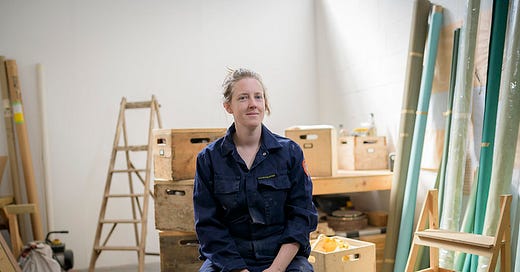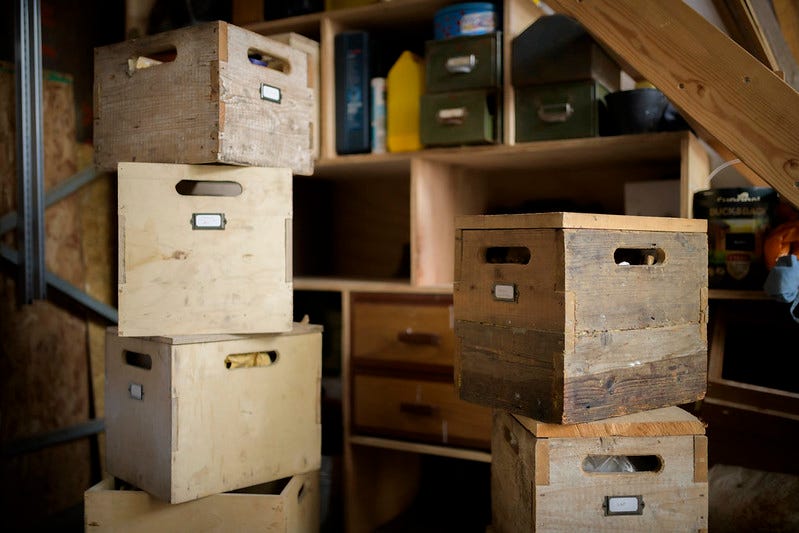Rip it up and start again
The artist addressing the issue of sustainability with sculpture plus one man's search for cows in fields
Good morning! I’m Sarah Hartley and this is The Northern Eco weekly update from the north of England. As you’ve received this newsletter then either you subscribed, or someone forwarded it to you. If the latter, then you can return the favour using the handy little button below.
For this week’s newsletter we have something a little different - a guest post from the brilliant arts journalist Laura Davis of Stored Honey. Laura interviews an artist who is making a statement about sustainability using sculpture. Showing that environmental action isn’t all campaigning, sculptor Jo Lathwood launches a Sustainable Manifesto with her latest show at The Lowry in Salford where the sculpture will end up being recycled by the audience.
Reduce, Reuse, Recycle: The Sustainable Manifesto
We’ve all seen them - those worn down bits of grass or gaps in the hedge where repeated use has created a pathway where one had not been designed. Sculptor Jo Lathwood will be spending several weeks building a boardwalk through one of the Lowry’s galleries, yet it’s the alternative, un-signposted routes that she is most intrigued by - the journeys visitors will make of their own accord through the space she’s created.
Her exhibition Making Up opens at the Salford arts centre later this month, and she currently doesn’t entirely know what it will look like. She has an idea, a maquette of the gallery and various sketches to help her imagine the finished work, and piles upon piles of pre-used wood - some from her previous exhibition in Plymouth and palettes saved by the Lowry from delivery trucks. She knows it will take around 600m of slats to create the boardwalk and a further 250m of chunkier wood to build the circular structure it will lead to. But the actual finished product? She doesn’t have a comprehensive answer.
Lathwood says: “If you've got recycled timber there's a logistical side where you have to be able to know how you're going to do it, but then there's also this nice freedom that you don't really know what it's going to look like because you're cobbling together all these different bits of wood.
“So I know how it's going to work in regards to the layout but I can't make an image of it yet, which from the sculpting point- of-view I really like because then there's more excitement that you're working towards something that didn't exist before.”
During the exhibition’s first few weeks, visitors to the Lowry will be able to watch Bristol-based Lathwood constructing the curved boardwalk on a CCTV livestream of the art centre’s cellar workshops - and later in the gallery itself. Once it is completed, they will be able to experience it in person, making their way to a rotating platform before returning to the beginning of the boardwalk as part of a circular system.
A second gallery will display her Sustainable Manifesto, works on paper, a short film and a text work on the wall.
“There's a part of me that's really interested in boardwalks as a sort of organised experience or a suggested journey,” says Lathwood.
“Sometimes boardwalks are placed because there's a boggy bit of field or they're practical. But sometimes you get those particular pathways that we make, you know if you've go a bit of urban planning, and then everybody cuts the corner off? It’s rubbed out the grass because most people want to go that way.
“So I want to provide a pathway to suggest to people that they can walk on this artwork, on this very controlled journey. But there's no obligation to do that - you could just step off it and walk around the gallery in any capacity that you wanted to.”
Once you have reached the turning circle at the end of the boardwalk you will be able to read the text on the wall of the adjacent gallery. In fact, the way it has been designed makes this is the only spot where it can be seen in an undistorted state.
Take a circular journey
The journey’s circular pattern reflects Lathwood’s own artistic process. The final stage of her exhibition is to break down the structure and turn the wood into around 800 boxes that people can take to use in their homes.
“So basically, the plan is just to make more work for myself,” jokes Lathwood.
“The idea came about because I was looking at the history of the Salford docks and why the Lowry came to exist. Obviously this big brownfield site used to be a working industrial space and I was looking at why it's not any more. The main explanation was that we just got very good at packaging things.”
The development of containerisation allowed goods to be shipped in much greater quantities on large vessels that were too big for the Manchester Ship Canal so the Salford Docks fell out of use.
“It seems kind of crazy that a simple design of packaging made that place redundant,” says Lathwood. “So it seems like a relevant thing to make, and I wanted to make something functional. I like this idea of all these materials coming together, forming a thing and then disbanding, and then coming together and disbanding. That's what we do a lot in the world anyway, just move things around.”
Between reusing and limiting the transportation of materials - as well as the wood in her structures, her large scale drawings are created on stuck-together scrap paper - Lathwood aims to be as sustainable in her practice as possible, but she does face challenges.
“I want to be sustainable - I don't know if I am sustainable. I'm trying to do everything that I can. That’s something I'm processing within my own practice,” she says.
“It's relatively easy for me to use older materials. As a sculptor I think there's more interest in using used wood than a brand new piece of cedar or timber, I like the story that's behind it. What's not easy is that my work can only really exist if there's an exhibition that's going to host it.”
The three Rs
She refers to the three Rs of sustainability - Reduce, Reuse, Recycle - and how they were coined in order of preference. While most people tend to focus on recycling, it would be more sustainable to reduce the number of things we acquire and find a way of reusing them before reaching for the recycle bin. Yet capitalism, she says, benefits more if we recycle rather than limit our purchasing.
“I think the political system makes everything a lot more complicated because there are examples within governmental systems that would make everything more sustainable, but it needs to come from those levels,” says Lathwood.
“It needs to come from institutions and companies as opposed to the individual. The individual can definitely do stuff but the change is really going to only happen if governments sort it out.”
Jo Lathwood: Making Up is at The Lowry, Salford, from January 20 to March 3. More details here.
Subscribe for more arts journalism from Laura Davis at Stored Honey here.
If you’d like also to submit a guest post post for readers of The Northern Eco - here’s how.
The three most clicked links from last week
Stop the Sewage | Open a public inquiry into water company regulation
The Carbon Literacy Project
Be The Future
In other news
🧜♀️ If you enjoyed last week’s interview with mermaid Helen Hill, there’s a chance to hear from her directly at the Better Business Summit from 17 - 19 January in Manchester.
🌳 Bradford nature reserve would be 'first for West Yorkshire' writes Chris Young at the Telegraph & Argus .
🐄 Where have all the cows gone? This is a long but fascinating read from Charlie Clutterbuck at Yorkshire Bylines looking at why you’re less likely to see cows in fields these days. “A few years ago, if you had driven around the lanes of West Yorkshire or East Lancashire, you’d have seen fields full of cows – herds of peaceful dairy animals with swollen udders, munching their way through acres of pasture. When they were called in from the fresh air for milking, they would line up and get some exercise walking to the milking parlour. Not anymore”
If you enjoy The Northern Eco, it would make a big difference if you invited friends to subscribe and read with us. If you refer friends, you will receive benefits that give you special access to exclusive content, the full archive and more. If you’re already a paid member then you will receive a free extension to your subscription.
1. Share The Northern Eco. When you use the referral link below, or the “Share” button on any post, you'll get credit for any new subscribers. Simply send the link in a text, email, or share it on social media with friends.
2. Earn benefits. When more friends use your referral link to subscribe (free or paid), you’ll receive special benefits.
Get 1 month free for 3 referrals
Get 3 months free for 5 referrals
Get 6 months free for 25 referrals







